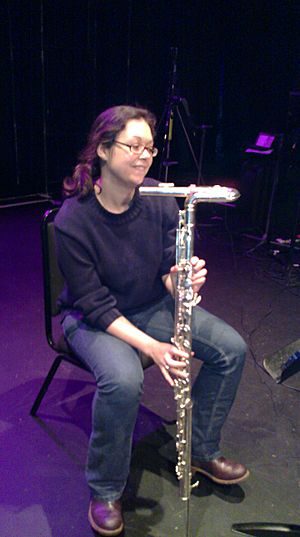Bass flute facts for kids
The bass flute is a large member of the flute family. It plays notes that are one octave (eight notes) lower than a regular concert flute. Because it's so long (about 146 centimeters or 57 inches), it usually has a special J-shaped curve at the top. This curve helps the player reach the part where they blow air. Bass flutes are often used in flute choirs. They are not usually played alone because their sound can be easily covered by other instruments.
Some companies, like Kotato and Fukushima, make a special bass flute in the key of F. People sometimes call this instrument a Contra-alto flute.
Contents
Different Names for the Bass Flute
Before the mid-1900s, the name "bass flute" sometimes referred to the alto flute, especially in Great Britain. For example, in Gustav Holst's famous piece The Planets, the part for "bass flute in G" was actually for an alto flute. In 1910, a person named Abelardo Albisi invented a bass flute called the albisiphone. This instrument was used by composers like Mascagni and Zandonai in their music.
How the Bass Flute Sounds and is Built
Sound and Range
The bass flute can play notes from C3 (one octave below middle C) up to C6 (two octaves above middle C). When you read music for the bass flute, the notes are written an octave higher than they actually sound. This is similar to how music is written for a regular concert flute. Notes written above A6 are not used very often. They are hard to play and don't sound as good. Also, some higher notes can sound a bit sharp. Players can fix this by changing how they blow or by using different finger positions.
How it's Made
Many bass flutes have a "C foot" instead of the "B foot" that is common on other flutes. The C foot makes the instrument a bit shorter. This helps the flute respond faster and makes its sound brighter and more lively. A shorter flute is also lighter, which makes it easier for the player to hold.
Most bass flutes are made with silver-plated parts. They often have "trill keys." These keys help make some middle notes more stable and allow players to play quick trills between certain notes. To help with the weight, some bass flutes have special supports. Kotato basses, for example, have a graphite rod that rests on the player's chair. Other makers have added a "crutch" for the left thumb. This helps some players control the instrument better. A Dutch flute maker, Eva Kingma, even created a bass flute that stands upright. This design allows the floor to support the instrument's weight.
Music for the Bass Flute
More and more composers are writing music for the bass flute. Some pieces include Two for Two by Katherine Hoover and Karuna by Bill Douglas. Other works are Archelogos II by Sophie Lacaze and Obstinato by Mike Mower. You can also find A Small Sonata for a Large Flute by Gary Schocker and Ellipse by Lorenzo Ferrero.
Important pieces for bass flute also include Ethers by Tristan Murail for solo bass flute and a small group of instruments. There's Mnemosyne by Brian Ferneyhough for bass flute and tape, and Lamento a la muerte de Raúl Lavista by Mario Lavista for solo bass flute. Moss Garden by Michael Oliva also uses bass flute and tape. John Palmer wrote Inwards for bass flute and live-electronics. Other pieces are She Cried by Shiva Feshareki and Zoli by Marc Tweedie.
There are also studies and exercises being written to help players learn the bass flute. These help with things like holding the instrument, finger movements, and blowing air correctly. Peter Sheridan has asked composers to write new pieces and exercises for low flutes. One example is a set of 'Etudes for Low Flutes' by Hilary Taggart. The sixth part of Claude Bolling's suite for Flute and Jazz Trio, called 'Versatile', features the bass flute. Morton Feldman's "Crippled Symmetry" and John Cage's "Seven2" also have parts for the bass flute. Hans Pfitzner's 1917 opera Palestrina includes a part for an early bass flute. Another piece featuring the bass flute is John Mackey's "The Frozen Cathedral" (2013).
If you want to find a long list of music for bass flute and contrabass flute, you can look at the Repertoire Catalogue for Piccolo, Alto Flute and Bass Flute (2004) by Peter van Munster. There is also The Alto and Bass Flute Resource Guide which lists music by difficulty level. A company called Tetractys also publishes many works for bass flute.
Other Uses of the Bass Flute
A few jazz musicians have used the bass flute. These include flutist Jeremy Steig, who started using it on his 1975 album Temple of Birth. Saxophone players like Henry Threadgill, Brian Landrus, and James Carter have also played it. Even drummer Ronald Shannon Jackson sometimes played the bass flute as a second instrument. Hubert Laws plays the bass flute on his recording of "Amazing Grace." He plays the first part on bass flute, the second on alto flute, and the third on soprano flute.
In electronic music, Jack Dangers from the band Meat Beat Manifesto has sometimes used the bass flute.
You can hear a bass flute throughout George Bruns' music for The Jungle Book movie. It is also featured in the music for the original Pirates of the Caribbean ride at Disneyland.
Perhaps one of the most well-known uses of the bass flute is on the album Wave by Antônio Carlos Jobim.


